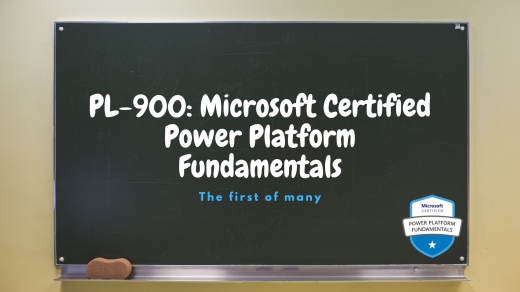PL-600: Microsoft Power Platform Solution Architect
Touch and Miss
Although you are most likely thinking… “Wow, the PL-600 is the highest Power Platform certification, I need to get this!”, take a step back. After taking the PL-600 exam myself, I was highly disappointed with my results, and to this day, still do not believe I am PL-600 worthy. Although sitting at the top of the Power Platform certification series, this exam focuses on close to no technological skills, but rather on the bigger picture, capturing, designing and deploying from a design perspective. Let’s take a further look.
What it Covers
The PL-600 exam focused on the design architecture of a solution. A solution model is not something that happens overnight, it should be the starting point of every project. In most cases, a solution architect will attend initial customer engagements to firstly identify the primary objectives and offer insight as to what paths will lead to success. A solution architect can also be split into various roles such as a technical and functional architect. As in the title of this roles, the candidates taking this exam should be well versed within the Power Platform from a technical skillset side but should also understand how to translate goals into functional requirements. Additionally, candidates require the PL-200 prior to taking this exam. If you have not written the PL-200, you can read about it here.
Again, this exam is a very broad exam on the Power Platform and focuses a lot on the generally approach to being a solution architect. Having both general knowledge and experience with the outlined skills are what I believe will guide you through passing this exam.
Skills Measured
As per the latest Microsoft Learn site for the PL-600 exam, Microsoft have outlined the key areas the exam will focus on.
- Perform solution envisioning and requirement analysis (35–40%)
- Architect a solution (40–45%)
- Implement the solution (15–20%)
Envision & Analyse
This section of the exam primarily focuses on how a solution architect is able to engage with high level stakeholders and conduct in depth discussions and analysis on business requirements. In line with these discussions, a solution architect should be able to envision what components or Power Platform products are required to reach success. This includes the possibility of building bespoke solutions, making use of Dynamics 365 products or advising stakeholders on existing ISV products within the AppSource.
Most of the solution architects time will be translating these business requirements and processes into high level documentation that can define a way forward. Being able to understand, draw out and map business processes is absolutely crucial, but more so being able to identify achievable outcomes and shortfalls. In parallel with building these requirements, a solution architect also needs to compile various risk factor analysis’s that could potentially set the deliverables back, as well as advise potential resolutions to mitigate foreseen issues.
Taking all the above into consideration, the solution architect also needs to familiarise themselves with the stakeholders’ environments and ecosystem to ensure that they are fully aware of what data sources and 3rd party systems need to be used. At this point, the solution architect would need to produce a variety of documentation elaborating on their findings, proposals, requirements and project plans. These documents could consist of:
- High Level Requirements
- Functional Requirements
- Non-Functional Requirements
- Person requirements
- Security Model
- Data Model
A solution architect will need to be very familiar with drafting these documents and processes whilst being able to present them to both high level stakeholders and the development team. With the completion of these documents, a solution architect should be able to determine a way forward, propose what steps need to be taken and advise what solutions can be used or are already available.
Solution Architecture
There is probably not enough time in the day to go over every little detail a solution architect performs. For the sake of this exam, a lot of content is referenced through general knowledge of how to architect a solution. When it gets to this point, a solution architect should have in depth knowledge on how solutions work, how to design the solutions model, being able to define the ALM framework to be used as well as the appropriate environment strategy, and how to bring them all together within a various solution strategy such as core, segmented and dependant solutions. If there is any data that needs to be migrated, the architect should also be able to streamline the data migration process following strict data protection policies.
Focusing on the technical side a bit more, aside from being able to draw up a solution data and security model, a solution architect should also be able to build the models themselves. This includes being able to create tables, relationships, security roles DLP policies. Additionally, when it comes to 3rd party integration, a solution architect should be familiar with building and managing these integrations. Whether integrating into internal Microsoft services into systems like Salesforce, the architect should understand how these connections work, be able to configure the connectors, define the integration path, and ensure that during development and both developments, the integration model is secure through authentication and the use of service accounts when needed. These technicalities, whether done by the architect or other developers, should be in line with the architects captured requirements and solution model.
Implementing Solutions
Lastly, a solution architect should be very familiar with deploying solutions through various means. This includes prepping solutions for deployment, running integration testing, running automated test cases and conflict resolutions, and determining best approach for deployments.
During deployments, a solution architect needs to stay on top of the product to ensure it is performing as expected. This includes factoring in possible bug fixes, change requirements or risks related to go live readiness. Should any issues arise, a solution architect should be able to resolve them accordingly.
Learning Content
My first go to is always the Microsoft Learn modules and paths. There is already a learning path specific to the PL-600 that will take you through all the material you should know for the exam. You can view a collection of learning paths, modules and units here. You can also view the exam study guide here which includes a free practice assessment. When you feel you ready, you can book the exam here.
Good luck on your exam 😉




